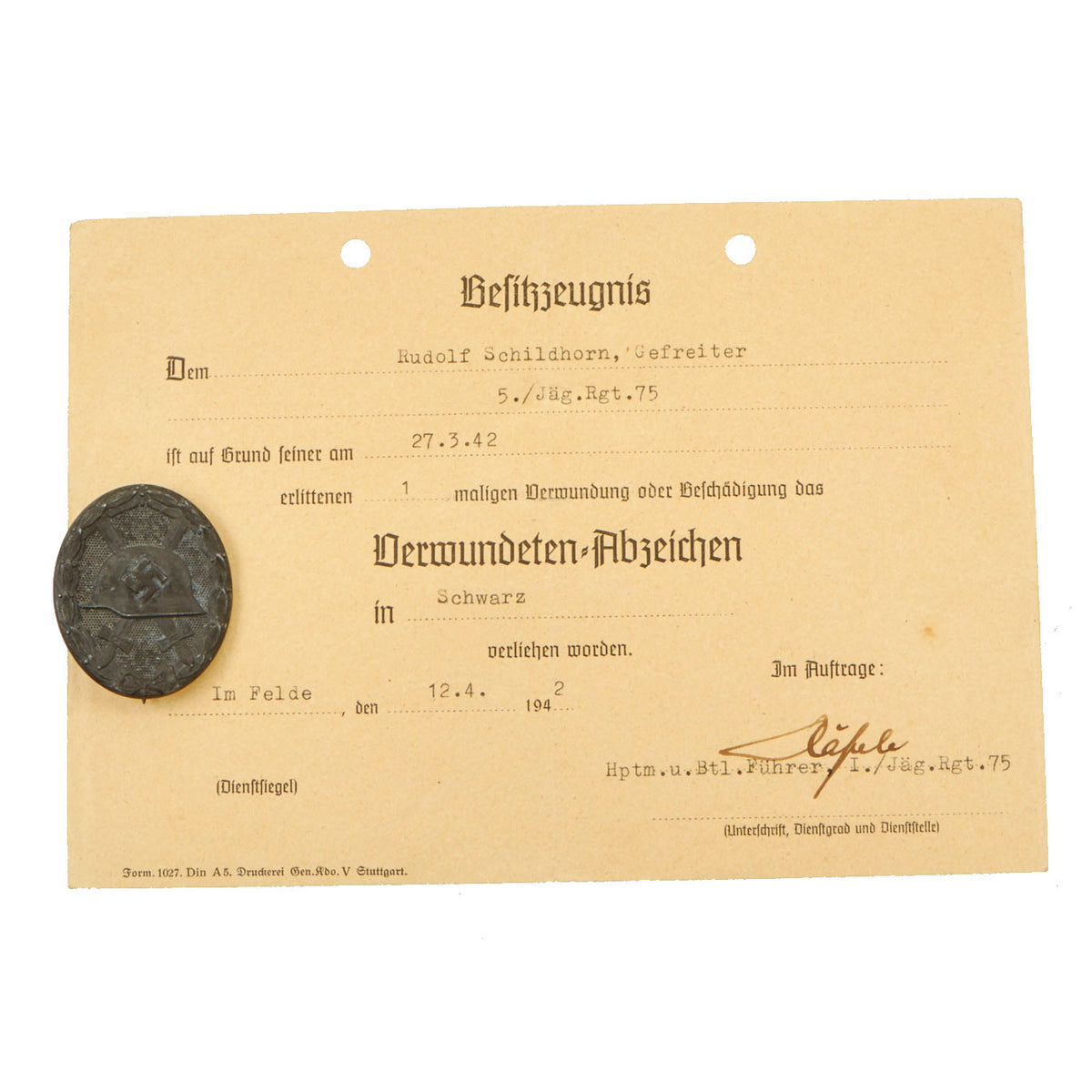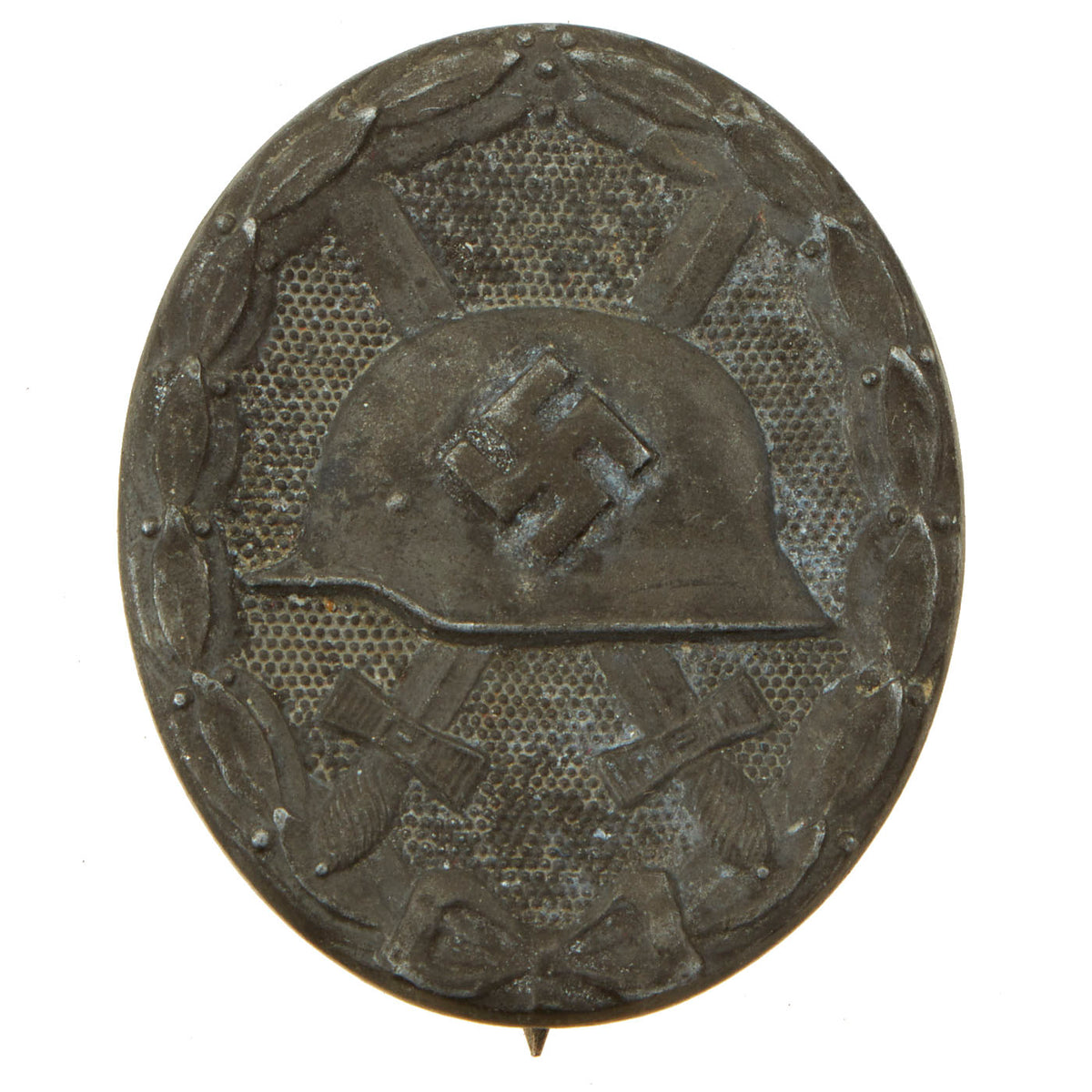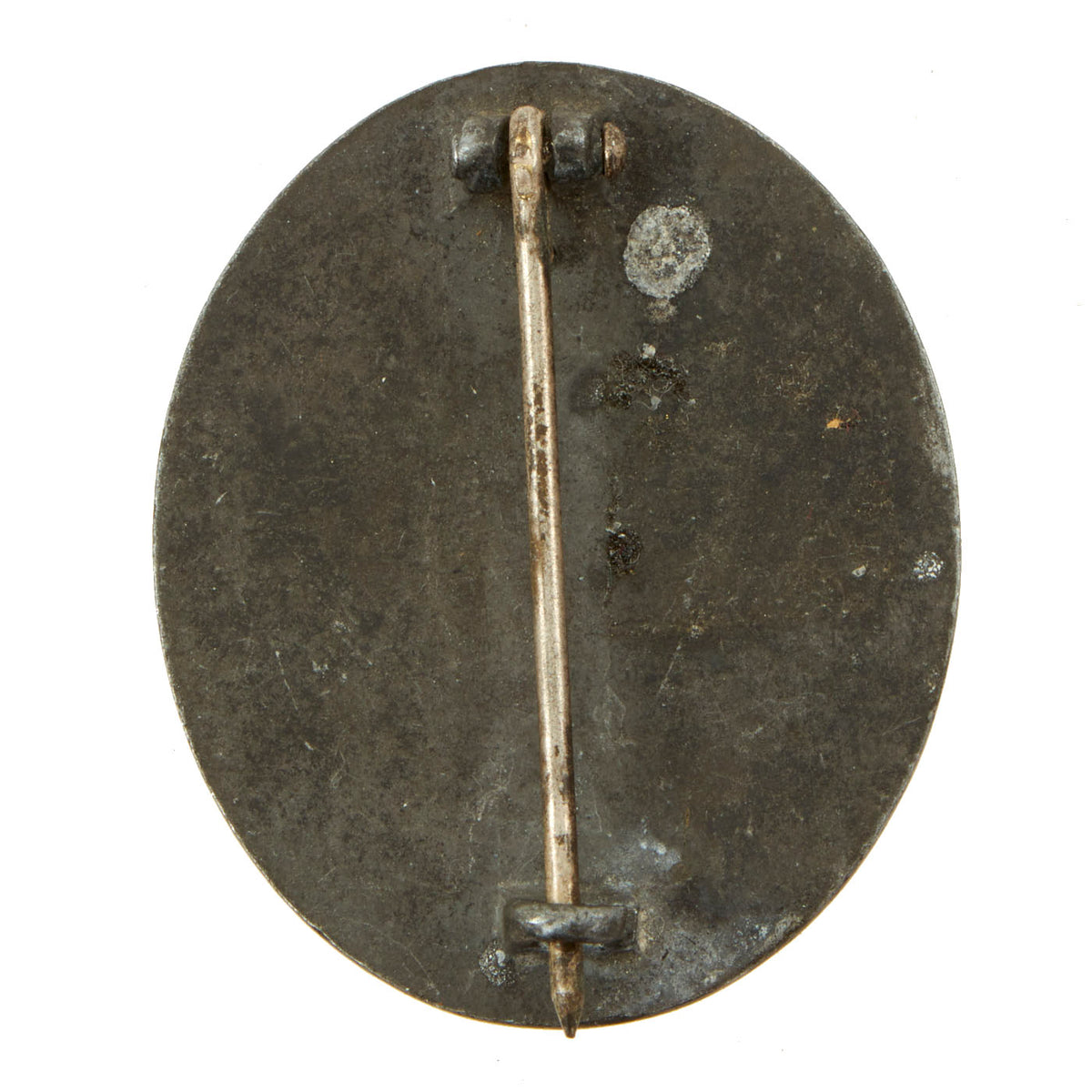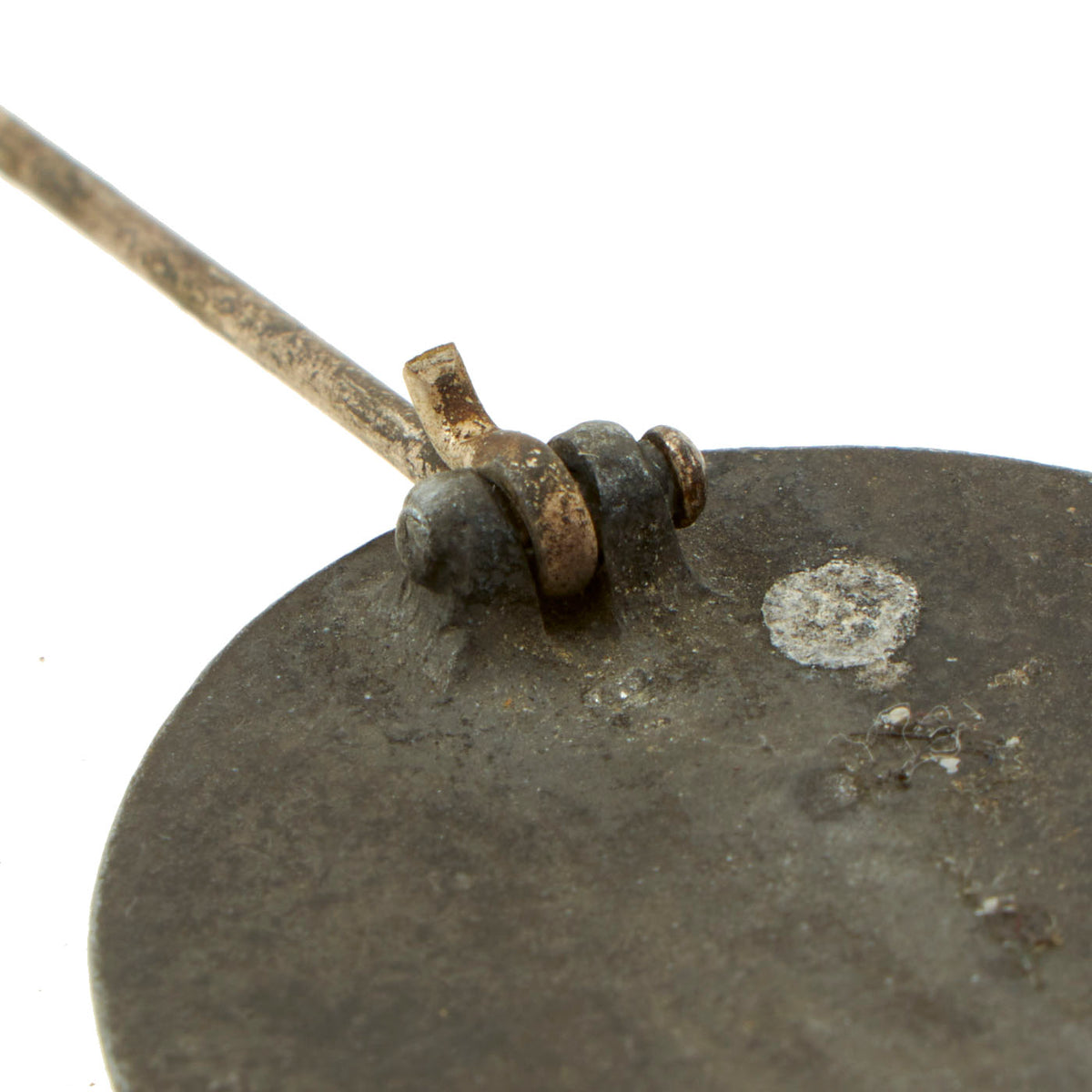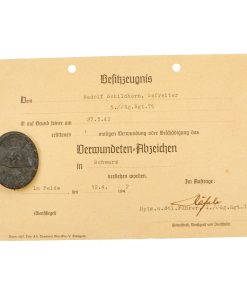Original German WWII Black Wound Badge with Named Award Document – Dated 1942 Original Items
$ 295,00 $ 118,00
Original Items: One-of-a-kind grouping. The Wound Badge (German: Verwundetenabzeichen) was a military decoration first promulgated by Wilhelm II, German Emperor on 3 March 1918, which was awarded to wounded or frostbitten soldiers of the Imperial German Army, during World War I. Between the world wars, it was awarded to members of the German armed forces who fought on the Nationalist side of the Spanish Civil War, 1938–39, and received combat related wounds. It was awarded to members in the Reichswehr, the Wehrmacht, SS and the auxiliary service organizations during the Second World War. After March 1943, due to the increasing number of Allied bombings, it was also awarded to wounded civilians in air raids. It was awarded when the wound was the result of enemy hostile action, with an exception being for frostbite.
The badge had three classes:
– Black (3rd class, representing Iron), for those wounded once or twice by hostile action (including air raids).
– Silver (2nd class) for being wounded three or four times.
– Gold (1st class, which could be awarded posthumously) for five or more times wounded.
The “progression” could be waived in the event of loss of a limb or eyesight; when such a severe wound occurred, the silver badge was awarded.
Badges were made of pressed steel, brass and zinc. All versions of the Wound Badge were worn on the lower left breast of the uniform or tunic. The badge was worn below all other awards on the left. It ranked lower than combat badges. There were 24 approved manufacturers of the Wound Badge. At first, the Wound Badge in Black was stamped from sheet brass, painted semi-matte black with a hollow reverse pin back attachment or of solid construction. From 1942, steel was used to make the badges. The Wound Badge in silver was made (before 1942) from silver-plated brass, and (after 1942) from lacquered zinc, and had a solid reverse with either a needle pin or a broad flat pin bar. The Wound Badge in Gold was a gilded version of the Wound Badge in Silver. In 1957, a revised version of the Wound Badge was authorised for wear; however, the previous type could still be worn if the swas were removed (for example by grinding).
This award document is approximately 8″ x 5.5, (20cm x 14cm), mid-weight paper document with black, printed Gothic/Fraktur script and typed in particular. The script indicates that Gefreiter Rudolf Schildhorn was awarded the Wound Badge 3rd Class (Schwarz) for injuries received the 27th of March 1942. The document bears the authorizing signature of a Hauptmann (Captain) and was presented on April 12th, 1945. The document shows yellowing typical of age. The badge is in excellent condition, totally genuine 3rd class Black Wound Badge with functional pin back and much of the original black finish.
Rudolf Schildhorn was a soldier who served with the 5th Jäger Division, 75th Infantry Regiment of the Wehrmacht.
The German 5th Infantry Division was formed in October 1934 and mobilized on 25 August 1939. The division’s troops were garrisoned in Konstanz, Ulm, and Freiburg. When formed, the division consisted of the 1st, 2nd, and 3rd battalions of the 14th, 56th, and 75th Infantry Regiments, the 1st, 2nd, and 3rd Battalions of the 5th Artillery Regiment, the 1st battalion of the 41st Artillery Regiment, and assorted 5th Division support units.
The division sat out the Invasion of Poland on the western front and first saw battle with the Second Army during the Campaign for France in 1940. Thereafter, the division was engaged in occupation duties in France until March 1941.
In April 1941, the division was sent to East Prussia and then took part in the invasion of the Soviet Union in June 1941, fighting in the vicinity of Vyazma until the end of the year, when the division was pulled back to France for a two-month refit.
In 1942, the division returned to the Eastern Front, took part in the fighting around Demyansk in March and April 1942 and fought in the area of Staraja Russa until the close of 1943.
In July 1942, the division was reorganized as a Jäger division and renamed the 5. Jäger-Division.
The division retreated through the areas of Vitebsk, Kovel, and Narev during 1944. In early 1945, the division fought in the vicinities of Neustettin and Dramburg, with its last battles fought around Freienwalde near the Oder River during the Battle of Berlin in April 1945. The division surrendered to the Red Army at Wittenberge.
Both items come ready for further research and display!
The main purpose of the German Jäger Divisions was to fight in adverse terrain where smaller, coordinated units were more facilely combat capable than the brute force offered by the standard infantry divisions. The Jäger divisions were more heavily equipped than the mountain division, but not as well armed as a larger infantry division. In the early stages of the war, they were the interface divisions fighting in rough terrain and foothills as well as urban areas, between the mountains and the plains. The Jägers (means hunters in German) relied on a high degree of training, and slightly superior communications, as well as their not inconsiderable artillery support. In the middle stages of the war, as the standard infantry divisions were downsized, the Jäger structure of divisions with two infantry regiments, became the standard table of organization.
In 1943, Adolf H declared that all infantry divisions were now Grenadier Divisions except for his elite Jäger and Mountain Jaeger divisions.
Fast Shipping with Professional Packaging
Thanks to our longstanding association with UPS FedEx DHL, and other major international carriers, we are able to provide a range of shipping options. Our warehouse staff is expertly trained and will wrap your products according to our exact and precise specifications. Prior to shipping, your goods will be thoroughly examined and securely secured. We ship to thousands clients each day across multiple countries. This shows how we're dedicated to be the largest retailer on the internet. Warehouses and distribution centres can be located throughout Europe as well as the USA.
Note: Orders with more than one item will be assigned a processing date depending on the item.
Before shipping before shipping, we'll conduct a thorough inspection of the items you have ordered. Today, the majority of orders will be delivered within 48 hours. The delivery time will be between 3-7 days.
Returns
The stock is dynamic and we cannot completely manage it because multiple stakeholders are involved, including our factory and warehouse. So the actual stock may alter at any time. It's possible that you may not receive your order once the order has been made.
Our policy is valid for a period of 30 days. If you don't receive the product within 30 days, we are not able to issue a refund or an exchange.
You can only return an item if it is unused and in the same state as the day you received it. You must have the item in its original packaging.
Related products
Uncategorized
Angolan Rebel 1970s era 60mm Inert Display Mortar from Angolan Civil War Original Items
Uncategorized
Uncategorized
Uncategorized
Uncategorized
Uncategorized
Uncategorized
Armoured Fighting Vehicles of the World: AFVs of World War One (Hardcover Book) New Made Items
Uncategorized
Uncategorized
Band of Brothers ORIGINAL GERMAN WWII Le. F.H. 18 10.5cm ARTILLERY PIECE Original Items
Uncategorized
Uncategorized
Uncategorized
Uncategorized
Uncategorized
Uncategorized
Uncategorized
Uncategorized
Uncategorized
